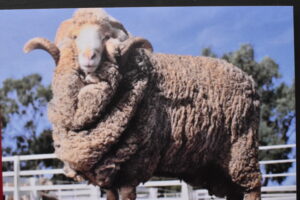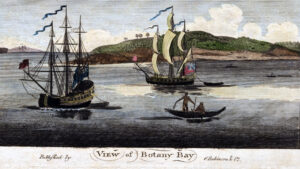Samuel Marsden was born in Farsley, West Yorkshire in June (or July) 1764
There are references to Marsden all around the village of Farsley, (including a monument on Town Street depicting a ram’s head and a portrait of the man himself, erected c 1934).

Image of a merino sheep
A brief description of Marsden and his influence on woollen textiles is provided in a previous blog post on our website here.
Visitors to our Archive often express an interest in the social and unofficial version of the histories related to Sunny Bank Mills and the Woollen Textile Industry. Evidence of Marsden’s stories are difficult to outline as fact, due to the exaggerated accounts of his successes in his own journals and letters (for the purpose of reporting back to his governors in England under king George III) and the transcription of oral witness accounts years after events had taken place.
Below is a version of the journeys taken by a ship named William that I have compiled (including the first passage taken to Australia by The Reverend Samuel Marsden and his wife in 1793).
Note, traditionally ships are referred to as she… (see explanation here)

Image of Botany Bay 1790 State Library Of NSW Dixson Library The Lady’s Magazine, January 1790, Published by GGJ and Robinson
The William was built in France in 1770 as a merchant vessel. By 1791, (under the command of John Ralph Moss) the ship left London on 25th February but was driven ashore by a blizzard at Sheerness (mouth of the River Thames). William departed for the south seas from Downs (near Dover) on 3rd April. She proceeded to Delagoa Bay (Zanzibar) reported on 28th August. By 18th January 1792 she was reported north of the Falkland Islands. The ship had therefore doubled both capes by the time it arrived in The Pacific touching at the Juan Fernandez islands (off Santiago/Chile) in November 1792 to gather fresh provisions and firewood to counter scurvy. The William then passed Gravesend (inbound) along the Thames Estuary on 21st April 1793 carrying 141 tonnes of sperm whale oil, 5 tonnes of whale oil and 2347 seal skins. This illustrates the kind of journeys that ships were making across parts of the globe at that time. The oil was being used as lubricant in machinery but mostly for the manufacture of candles.
On the 21st of September 1793 William Folger captained The William and left England for Botany Bay (New South Wales) via Cork (south coast of Ireland) and Brazil.
The ship departed from Hull at the beginning of September 1793. They were delayed at Spithead and again at Cork Harbour (Ireland) due to the weather and the ongoing war between Great Britain and France. They left Cork on 30th September accompanied by a convoy of forty other merchant ships and a ship of war. The single vessel (The William) contained 2080 barrels of beef and pork, The ‘New Colony’s’ newly appointed assistant chaplain Reverend Samuel Marsden and his wife, Elizabeth (nee Tristan). Along with convicts including one female – Maria Smith – referred to in Marsden’s journal as the bad girl (Smith had been sentenced to be transported for stealing two pieces of muslin cloth and a pair of worsted socks valued at 12d.
They stopped at Rio De Janeiro (for wood and fresh provisions) to continue to Botany Bay with further stops along the way. The journey took 171 days. They met storms at sea and had to land at Devil’s Island (Tasmania) during the crossing.
According to sketched accounts of what had happened during this time. A section of the transcription is included below …
…To add to his anxieties (referring to the reverend), Mrs Marsden was confined on shipboard, in stormy weather, and under circumstances peculiarly distressing “though the mother and daughter did well” But the same day the scene brightened; the perils and privations of the voyage were drawing to a close, and they were in sight of their future home – that magnificent Australia – destined hereafter to assume, perhaps a foremost place among the nations of the earth, though scarcely known to Europe when Mr Marsden first stepped upon its shores; and valued only by the British Government as a settlement for the refuse of our jails. He thus gives us utterance to the feelings of a grateful heart.
During the stop off at Devil’s Island, Tasmania, Elizabeth gave birth to their first of eight children, Anne, on the 2nd of March 1794. From reading more honest accounts in Marsden’s journal entries, Elizabeth did go into labour on board the ship and Marsden attempted to appoint the female convict ‘Smith’ to take on the role of a nurse. Smith hid in the captain’s quarters. The child was born without assistance and the ship arrived at Port Jackson (Now Sydney Harbour) 7 days later 10th March 1794.
According to Marsden’s journal,
March 2nd – I shall ever retain a grateful sense of mercies received this day, and upon the deliverances wrought. The lord is good, and a stronghold in the day of trouble, and knows them that fear him… As soon as I had the opportunity to go deck, I had the happiness again to behold the land: It was a very pleasing sight, as we had not seen it since the 3rd of December…
Marsden and his wife Elizabeth settled at Parramatta, where a church has since been erected on the site where they first settled. He returned to England in 1807 and brought with him fleeces from his own hardy sheep stock that were then woven into Worsted Suit cloth at Parks Mill in Rawdon. He wore a suit made from the cloth on a visit to King George to report on the progress of the colony. King George was so impressed with the quality of the worsted woven cloth that he gave to Marsden Merino sheep from his experimental farm at Windsor to take back to Australia and introduce into his stock. And so, the journey of the wool began. By the 1880s the Clippers were making journeys across from New South Wales to Hull in record passage times of between 73 to 77 days carrying Merino wool direct from New South Wales to mills in Yorkshire.
It is believed that in 1794 The William was intending to continue her journey on to China. However, according to logs, she was recorded back in the South Pacific on another whaling expedition months after dropping her cargo off in Australia.
Now, in 2023. China accounts for 90% of Australian wool exports on container ships along Pacific routes, the route originally intended for The William, but never made it.

Image Merino wool in Sunny Bank Mills Archive
References and Links
Lloyds Register Heritage and Archive Section https://hec.lrfoundation.org.uk/archive-libraryState Library New South wales: [May 2023]
Reference to Ship William built 1770 https://en.wikipedia.org/wiki/William_(1770_ship)[May2023]
Imperial War Museum Website Why Do Ships Have a gender? https://www.iwm.org.uk/history/why-do-ships-have-a-gender#:~:text=Another%20tradition%20is%20to%20consider,protecting%20a%20ship%20and%20crew. [July 2023]
Marsden Online Archive https://marsdenarchive.otago.ac.nz/[June [June 2023]
Ref to ship journey/William and Marsden’s Journals https://www.gutenberg.org/cache/epub/41258/pg41258-images.html [June 2023]
1883-1895 The Australian Wool years https://www.rmg.co.uk/stories/topics/1883-95-australian-wool-years [June 2023]
Financial Review China Rides On Our Sheeps Back https://www.afr.com/companies/agriculture/china-welcomes-australian-wool-as-farmers-anticipate-bumper-season-20210708-p58872 [July 2023]
Back To Blog Next (From Dogstooth to Birdseye – Heritage Open Days 2023) Prev (Why do we have a cake decorating turntable in the Archive?)Tags
General Museum & Archive Arts & Culture
